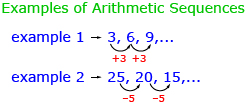Lesson 1
1. Lesson 1
1.7. Explore 3
Module 1: Sequences and Series
Arithmetic Sequences Increase by a Specific Factor

In Try This 2 you may have recognized that an arithmetic sequence increases by a specific factor. Example 1 in the image shows an arithmetic sequence that increases by a specific factor, 3, as you move between terms. An arithmetic sequence can also have terms that decrease by a factor (e.g., −5), as shown in example 2.
You will now explore methods used to find any term in a sequence. In the first method you will repeat many calculations on your calculator. In the second method you will apply a formula.
Finding a Term in an Arithmetic Sequence
Calculator Method
In Try This 1 you came up with a method to find the 20th number in the arithmetic sequence 10, 14, 18, ….
You may have started with the first term, and then used a calculator to repeatedly add the number 4, which is the common difference in this sequence.
Many calculators can simplify repeated calculations.
Follow these steps to find the 20th term of the sequence 10, 14, 18, ….
Step 1: Press ![]()
![]() , the first term in the sequence.
, the first term in the sequence.
Step 2: Press ![]() then
then ![]() then
then ![]() . The result will be the second term in the sequence.
. The result will be the second term in the sequence.
Step 3: While counting the terms, continue to press ![]() until you obtain the value of the 20th term. You do not need to press
until you obtain the value of the 20th term. You do not need to press ![]() then
then ![]() repeatedly.
repeatedly.
Try This 3

iStockphoto/Thinkstock
- Use the calculator method to find the 100th term in 10, 14, 18, ….
- What do you think are the advantages and disadvantages of evaluating repeated calculations with a calculator?
![]() Place a copy of your responses in your course folder.
Place a copy of your responses in your course folder.